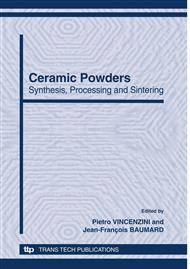p.1
p.8
p.16
p.22
p.27
p.34
p.44
p.50
p.56
A New Powder Filler, Obtained by Applying a New Technology for Fly Ash Inertisation Procedure
Abstract:
In the last years several projects have been developed for treatment of fly ash with the aim of their reuse. A final target of these researches is to evaluate the real performance of the new materials obtained by the treatment and the actual and, if the case, potential markets for the foreseen products. Indeed, the use of a recycled inert would reduce the consumption of natural resources and this is one of the main environmental EU target. Examples are clinkering, road asphaltation and some construction work where specific performances are requested. Moreover, the reuse of inerted fly ash will obtain a reduction of carbon dioxide produced by the necessary treatments of primary materials, as limestone in concrete production. At the University of Brescia (Italy) a new process, based on colloidal silica medium, has been developed to inertise fly ashes, containing heavy metals. This approach appears to be quite promising for industrial application in view of the easiness that can be foreseen in applying it to existing plants treating industrial fly ash. The obtained inert product is a powder, that can be employed as a filler in several application. In this work we present first results about characterization of this new powder material, that can be applied as a filler.
Info:
Periodical:
Pages:
27-33
Citation:
Online since:
October 2010
Price:
Сopyright:
© 2010 Trans Tech Publications Ltd. All Rights Reserved
Share:
Citation:


